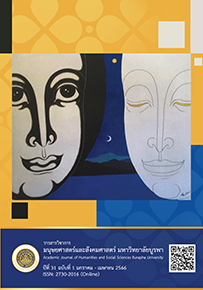Space and the Cultural Politics of Chinese-Thai Identity in V. Vinicchayakul’s Ethnic Romance Novel-Sunflower
Main Article Content
Abstract
This article aims at studying V. Vinicchayakul’s ethnic romance novel titled Thantawan (Sunflower) in terms of the cultural politics of Chinese-Thai identity. The research design is addressed by the spatial conception along with literary conventions of the romance novel. It is found that the house is foregrounded. The house is not merely a physical setting—one of fictional elements. It instead signifies the interplay between place and space. The house is related to social status, class, and capitals. The house is thus a contested space between Thai identity, overseas Chinese identity, and Chinese-Thai identity, going hand in hand with plot development and characterization. The power which determines identity also manifests through the conflict between domestic and public space. Empowering the female protagonist as a Chinese woman capitalist, the two spaces define the female protagonist as a progressive woman who works in the public sphere. Yet she can also own her domestic sphere. This reshapes a Chinese-Thai identity through individuality and the power over certain spaces. The contribution of this research is to propose an alternative approach to the study of Chinese in Thai literature with special reference to the complexity of Chinese-Thai identity beyond the grand narrative of Teochew self-made men.
Downloads
Article Details

This work is licensed under a Creative Commons Attribution-NonCommercial-NoDerivatives 4.0 International License.
บทความทุกบทความเป็นลิขสิทธิ์ของวารสารวิชาการมนุษยศาสตร์และสังคมศาสตร์ มหาวิทยาลัยบูรพาเท่านั้น
References
กาญจนา แก้วเทพ. (2557). ศาสตร์แห่งสื่อและวัฒนธรรมศึกษา. ภาพพิมพ์.
กิติยา วิทยาประพัฒน์. (2555). สถานภาพและบทบาทสตรีในครอบครัวไทยเชื้อสายจีนในนวนิยายไทยแนวชีวิตครอบครัว ปี พ.ศ. 2538-2546. [วิทยานิพนธ์อักษรศาสตรมหาบัณฑิต, จุฬาลงกรณ์มหาวิทยาลัย].
คริส เบเคอร์ และผาสุก พงษ์ไพจิตร. (2559). ประวัติศาสตร์ไทยร่วมสมัย (พิมพ์ครั้งที่ 5). มติชน.
ธานีวัฒน์ บุญโต. (2542). ภาพสะท้อนวิถีชีวิตชาวจีนในวรรณกรรมของหยก บูรพา. [ปริญญานิพนธ์การศึกษามหาบัณฑิต, มหาวิทยาลัยศรีนครินทรวิโรฒ].
นัทธนัย ประสานนาม. (2553). รอยวสันต์ ของยุวดี ต้นสกุลรุ่งเรือง: การเขียนอัตลักษณ์และประวัติศาสตร์ของผู้หญิงกวางตุ้งพลัดถิ่น. วารสารภาษาและหนังสือ, 41, 127-170.
นัทธนัย ประสานนาม. (2559). ศัตรูที่รัก: คุณค่าสงครามกับสงครามคุณค่าในคู่กรรมของทมยันตี. ในสุรเดช โชติอุดมพันธ์ (บรรณาธิการ), ถกเถียงเรื่องคุณค่า (หน้า 445-508). วิภาษา.
พัชรี วราศรัย. (2537). นวนิยายที่เสนอภาพสังคมชาวจีนในเมืองไทย. [วิทยานิพนธ์อักษรศาสตรมหาบัณฑิต, จุฬาลงกรณ์มหาวิทยาลัย].
เพ็ญนภา หมอนสอาด. (2550). ภาพลักษณ์ของชาวจีนในเมืองไทยที่ปรากฏในนวนิยายไทย พ.ศ. 2512-2533. [วิทยานิพนธ์อักษรศาสตรมหาบัณฑิต, จุฬาลงกรณ์มหาวิทยาลัย].
ว.วินิจฉัยกุล. (2539). ทานตะวัน. ดอกหญ้า.
ศุภมณฑา สุภานันท์. (2554). พื้นที่ เวลา อัตลักษณ์ และการสร้างความหมายทางสังคม. วารสารนิเทศศาสตร์ มหาวิทยาลัยกรุงเทพ, 29(3), 186-204.
เสนาะ เจริญพร. (2548). ผู้หญิงกับสังคมในวรรณกรรมไทยยุคฟองสบู่. มติชน.
สุชาวดี เกษมณี. (2555). วรรณกรรมไทยที่สะท้อนอัตลักษณ์จีนในสังคมไทย. [วิทยานิพนธ์ปรัชญาดุษฎีบัณฑิต, มหาวิทยาลัยเกษตรศาสตร์].
Barker, C., & Jane, E. A. (2016). Cultural studies: Theory and practice (5thed.). Sage.
Jordan, G., & Weedon, C. (1995). Cultural politics: Class, gender, race and the postmodern world. Blackwell.
Ramsdell, K. (2012). Romance fiction: A guide to the genre (2nd ed.). Libraries Unlimited.
Zarchi, M. A. (2011). Ethnic Chinese women in Thai novels: The negotiation of identity, gender and generational transitions. [Doctoral dissertation of Thai Studies, Chulalongkorn University].


